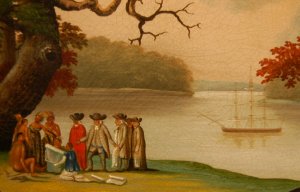 On March 4 1681, King Charles II of England, handed over a large piece of his North American land holdings along the North Atlantic coast to William Penn in order to pay off debts that king had owed to Penn's father, an admiral and politician. This land included the present-day states of Pennsylvania and Delaware. Penn immediately set sail and took his first step on American soil in New Castle, sailing up the Delaware Bay and Delaware River. William Penn was an early member of the Religious Society of Friends (Quakers), and a staunch advocate of democracy and religious freedom. His deep religious conviction had put him in prison several times in the Tower of London, where he wrote a book No Cross, No Crown, which became regarded as a classic in some quarters, encouraging a return to primitive Christianity.
On March 4 1681, King Charles II of England, handed over a large piece of his North American land holdings along the North Atlantic coast to William Penn in order to pay off debts that king had owed to Penn's father, an admiral and politician. This land included the present-day states of Pennsylvania and Delaware. Penn immediately set sail and took his first step on American soil in New Castle, sailing up the Delaware Bay and Delaware River. William Penn was an early member of the Religious Society of Friends (Quakers), and a staunch advocate of democracy and religious freedom. His deep religious conviction had put him in prison several times in the Tower of London, where he wrote a book No Cross, No Crown, which became regarded as a classic in some quarters, encouraging a return to primitive Christianity.Penn’s dream of setting up an area sympathetic to Quakers and thereby facilitating a mass emigration of English Quakers became a reality when the King granted this charter. It now seems extraordinarily generous and it made Penn the world's largest private (that is non-royal) landowner, with over 45,000 square miles, As well as the land he gained sovereign rule of the territory with all rights and privileges (except the power to declare war). Some Quakers had already moved to North America, but the New England Puritans were as hostile towards Quakers as Anglicans in England were, and some of them had already been banished to the Caribbean. The land of Pennsylvania didn’t belong to anyone, and was occupied by many native American tribes, but in this colonial age it was seen to have been owned by the Duke of York. He had acquiesced to the King, but he retained New York and the area around New Castle. In return, one-fifth of all gold and silver mined in the province was to be remitted to the King, and the Crown was freed of a debt to Penn’s family of £16,000, equal to £2,526,337 today.
Having proved himself as a scholar, Penn now had to demonstrate the practical skills of a real estate promoter, city planner, and governor for what he referred to as his "Holy Experiment" He named the province Pennsylvania meaning Penn's Woods. Under his direction, the city of Philadelphia was planned and developed and became Americas largest city until New York overtook it in 1810. It attracted many radical thinkers like early abolitionist Benjamin Lay who became a thorn in the side of the Quaker elite (see pod Feb 8). Philadelphia was also arranged to be grid-like with its streets and be very easy to navigate, unlike London where Penn was from, which had evolved organically in narrow, cobbled, winding roads. The streets in Philadelphia are named with numbers and tree names (a nod to the Sylan in Pennsylvania). Penn became well known for his good relations and successful treaties with the Lenape Native Americans. The peace between the Lenape Turtle Clan and Penn's successors would endure for over 70 years, and the success of this treaty made international renown and was remarked upon by Voltaire, who called it "... the only treaty never sworn to and never broken. However, Penn's Quaker government was not viewed favourably by the previous Dutch, Swedish colonists, and also earlier English settlers in what is now Delaware.
How has history judged his holy experiment and him as a person? Mainly positively, these are the worlds of American Historian Mary Maples Dunn: Penn liked money and although he was certainly sincere about his ambitions for a “holy experiment” in Pennsylvania, he also expected to get rich. He was, however, extravagant, a bad manager and businessman, and not very astute in judging people and making appointments... Penn was gregarious, had many friends, and was good at developing the useful connections which protected him through many crises. both his marriages were happy, and he would describe himself as a family man, all the public affairs took him away from home a great deal
Financial and family troubles sadly marked the end of his life. The burden of paying for his eldest son dissolute life, the many generous loans which he failed to press and being cheated by his financial advisor, all landed him in debtors' prison back in England. Although this turned into house arrest until rich Quakers payed off his debts for him. However, William Penn died penniless in 1718, at his home in Ruscombe, near Twyford in Berkshire, and Pennsylvania slowly drifted away from a colony founded by religion to a secular state dominated by commerce. The Quaker Oats cereal brand standing "Quaker man" logo, dating back to 1877, was identified in their advertising after 1909 as William Penn, but in 1946 the logo was changed into a head-and-shoulders portrait of the smiling Quaker Man. The Quaker Oats Company's website currently claims their logo is not a depiction of William Penn
The podcast and blog can be found on www.pogp.net
